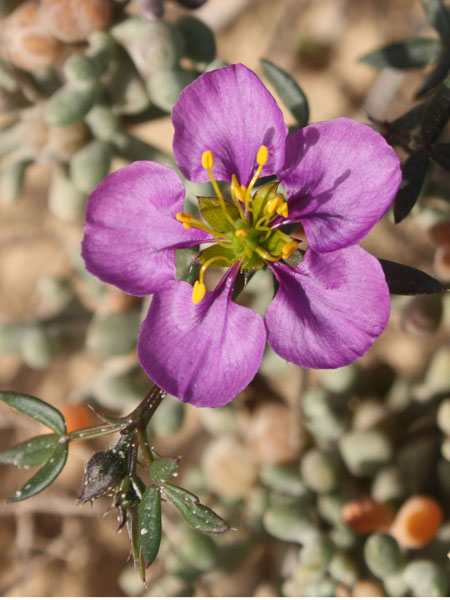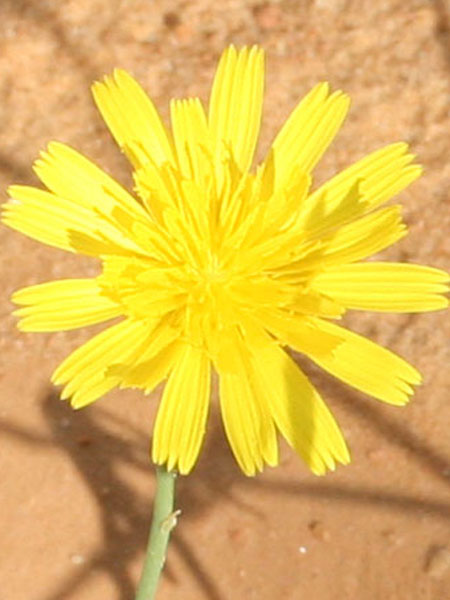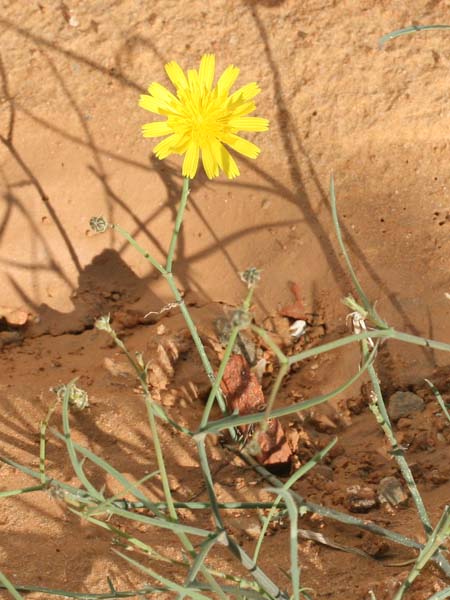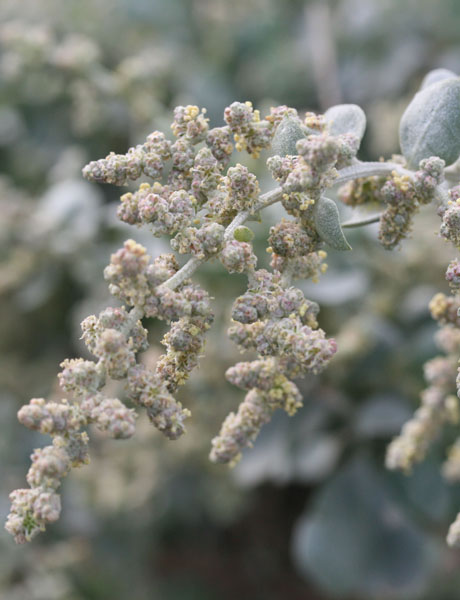Cakile maritima
Kingdom : Plantae / النّباتات
Division : Spermaphyta / البذريات
Clade : Magnoliophyta or Angiospermae / مستورات البذور
Class : Eudicotyledoneae / ذات الفلقتين
Order : Brassicales / الكرنبيات
Family : Brassicaceae [Cruciferacea] /الفصيلة الكرنبيّة أو الخردليّة الصليبيّة
Genus : Cakile
species : maritima
Chromosomes: 2n=18
Protologue
Scop., Fl. Carniol., ed. 2, 2: 35 (1772)
Synonyms
Cakile aegyptiaca Willd., Sp. Pl., ed. 4, 3: 417 (1800). Cakile latifolia Poir. in Lam., Encycl., Suppl. 2: 88 (1811). Cakile edentulata Jord., Diagn. Esp. Nouv. 344 (1864). Cakile littoralis Jord., Diagn. Esp. Nouv. 345 (1864). Cakile maritima subsp. maritima (Willd.) Nyman, Consp. Fl. Europ. 29 (1878).
Common names
Tunisia Arabic English French Tamazight
رشاد البحر
إسليح بحري
ككلي
رشاد البحر
Searocket
Buniade maritime
Cakilier
Tétine de souris
Roquette de mer
Toxic
no
Edible
yes
Latex
no
Botanic description
Genus description
"Chalice almost closed, disc of the ovary bearing four small glands, simple or no style, obtuse stigma, biarticulated, indistinguishable silicules, a single seed enclosed in each joint.
Species description
"Plant glabrous, spreading, rising to 40 cm above the ground, branching from its base, its branches are ascending.
Stems ascending or diffuse, branching, 20-40 cm. Leaves fleshy, deeply indented, with obtuse, uneven, gray-green lobes. Flowers bisexual large enough to 4 petals pink, whitish or purple, fragrant, 2 times longer than the chalice. Inflorescence bunches simple and long often with more than 20 flowers and fruits. Fruits short silique in two spear-shaped pieces.
Botanic References
Pottier-Alapetite G. (1981). Flore de la Tunisie Angiospermes –Dicotylédones (Apétales- Dialypétale , Première partie). Imprimerie Officielle de la République Tunisienne (Eds), 543p. Edouard LE FLOC’H, Loutfy BOULOS et Errol VELA. (2010). Catalogue synonymique commenté de la FLORE DE TUNISIE. République Tunisienne, Ministère de l’Environnement et du développement durable, Banque Nationale de Gènes. 500 p www.theplantlist.org
Biology
Life form Perennial Type form Psammophyte Photosynthesis C3
Phenology
Blooming
JanuaryFebruaryMarchAprilMayJuneJulyAugustSeptemberOctoberNovemberDecember
Fruiting
JanuaryFebruaryMarchAprilMayJuneJulyAugustSeptemberOctoberNovemberDecember
Map Localization
Ecology
Adaptation Colonizer of sea sands and resistant to spray with climates ranging from arid to humid. Represents an important ecological potential for its soil fixation. Salt bladder yes Invasive no
Geographical distribution
Localization Biocimatic stage Annuel pluviometry (mm) GPS Djerba (Sidi Jmour, Déc.2013) Higher arid 209 33°49'55.12"N/10°44'54.37"E Monastir (Skanès, Palais Nov.2014; Oct.2015) Inferior semi-arid 331 35°46'45.06"N/10°47'16.74"E Cap Bon (Soliman Fév. 2016) Superior semi-arid 444 36°43'49.02"N/10°28'2.02"E
General uses
Most of the plant is eaten raw or cooked, despite a marked bitterness. Its very bitter taste is used mainly as aroma. The young leaves are added to the salad, the older leaves can be mixed with soft tasting leaves. The dried root powder is mixed with cereal flours to make bread in case of famine.
Medicinal uses
"Properties: diuretic, aperitive, digestive, purgative. It is used to treat infectious diseases and to clean the lungs of viscous mucus. Recent properties: antifungals, insecticides, antibacterials, antinematodes, antioxidants and antimutagenics used in the treatment of demyelinating diseases, it could also help cure jaundice and dropsy and in case of scrofulous affections and lymphatic disturbances. Combined with vitamin B5, it is used in cosmetics as a moisturizer, skin and it also preserves the health and luster of hair.
NOTE : This website is not that of herbal medicine and assumes no responsibility for the negative effects of the use of plants. Seek advice from a professional before using a medicinal plant.
Systems / Organs / Effects
Digestive System Reproductive System Nervous System Urinary System Respiratory System Mouth / Teeth Hypolipedemic Hypoglycemic Anti-cancer Skin Scalp
Description of the seeds
Form elliptical External structure any Ornamentation any Type of seed Average length of 10 seeds 4± 0,1 (mm) Average width of 10 seeds 2 ± 0,1 (mm) Average thickness of 10 seeds 1 ± 0,1 (mm) Average mass of 100 seeds (g)
Test results
TPC DPPH ABTS+ FRAP Year mg GAE g-1 MS CI50 g ml-1 CI50 g ml-1 CE50 g ml-1 18,72± 0,66 157,87± 2,73 47,17± 0,57 246,40± 2,68 2016 Total Phenols content(TPC), Anti-radical potentialities against (DPPH, ABTS), Ferric reducing antioxidant power(FRAP)
Molecules : ADN / Proteins
Chromosomes : 18 Uniprot NCBI
Tunisian references
Ben Amor N, Jiménez A, Megdiche W, Lundqvist M, Sevilla F, Abdelly C.(2006). Response of antioxidant systems to NaCl stress in the halophyte Cakile maritima.Physiologia Plantarum 126: 446–457. Ben Hamed-Louati I, Bouteau F, Abdelly C et al. (2016). Impact of repetitive salt shocks on seedlings of the halophyte Cakile maritima. Environ Control Biol 54:23–30. Debez A, Ben Rejeb K, Ghars MA, Gandour M, Megdiche W, Ben Hamed K, Ben Amor N, Brown SC, Savouré A, Abdelly C. (2013).Ecophysiological and genomic analysis of salt tolerance of Cakile maritima. Elsevier 92: 64–72 9. Debez A, Hans-Peter Braun, Andreas Pich, Wael Taamalli, Hans-Werner Koyro, Chedly Abdelly, Bernhard Huchzermeyer. (2012). Proteomic and physiological responses of the halophyte Cakile maritima to moderate salinity at the germinative and vegetative stages JOURNAL OF PROTEOMIC S 75 : 5667 – 5694 11. Debez A, Benhamed K, Grignon C, Abdelly C (2004). Salinity effects on germination, growth, and seed production of the halophyte Cakile maritima, Plant Soil 262: 179-189. 10. Gandour M, Tamaalli W,Trabelsi N, Hessini K, Sebei K, Debez A, Abdelly C. (2011). How to optimize the seed and seed-oil production in the cash crop halophyte Cakile maritima? Journal of Medicinal Plants Research. 5: 5982-5987, 9. 13. Ghars M, Debez A, Smaoui A, Zarrouk M, Grignon C, Abdelly C (2006). Variability of fruit and seed-oil characteristics in Tunisian accessions of the halophyte cakile maritima (Brassicaceae) MA Khan and DJ Weber (eds.), Ecophysiology of High Salinity Tolerant Plants, 55-67. 14. Houta O, Neffati M, Amri H. (2012). Phenolic Contents and Antioxidant Potential of Cakile maritimum JBAPN . 2 (6), pp. 387. Ksouri R, Megdiche W, Debez A, Falleh H, Grignon C and Abdelly C .(2007). Salinity effects on polyphenal content and antioxidant activities in leaves of the halophyte Cakile maritima. Plant Physiology and Biochemistry, 45(3/4): 244-249. Ksouri R, Megdiche W, Debez A, Falleh H, Grignon C, Abdelly C (2007). Salinity effects on polyphenol content and antioxidant activities in leaves of the halophyte Cakile maritima. Plant Physiology and Biochemistry ,45: 244-249. Ksouri R, Megdiche W, Jallali I, Debez A, Magné C, Isoda Hiroko I, Abdelly C .(2012). Medicinal halophytes: potent source of health promoting biomolecules with medical, nutraceutical and food applications Critical Reviews in Biotechnology; 32: 289–326. 18. Nader Ben Amor, Ana Jime´nez, Wided Megdiche, Marianne Lundqvist, Francisca Sevilla and Chedly Abdelly .(2006).Response of antioxidant systems to NaCl stress in the halophyte Cakile maritima .Physiologia Plantarum 126: 446–457. Shiri M, Rabhi M, El Amrani A, Abdelly C (2015) The halophyte Cakile maritima reduces phenanthrene phytotoxicity. International Journal of Phytoremediation, 17(10): 925-8. Taamalli M, Ghabriche R, Amari T, Mnasri M, Zolla L, Lutts S, Abdely C, Ghnaya T(2014). Comparative study of Cd tolerance and accumulation potential between Cakile maritima L. (halophyte) and Brassica juncea L. Ecological Engineering : 71 623–627. Zarrouk M, Elalmi H, Benyoussef N, Sleimi IN, Smaoui A, Benmiled C, Abdelly C.(2003). Lipid composition of local halophytes seeds: Cakile maritima, Zygophyllum album and Crithmum maritimum, in: H. Lieth, M. Mochtchenko (Eds.), CasCrop Halophytes: Recent Studies, Kluwer Academic Publishers, Dordrecht, Boston, London, 121-126.
Other references
Ahmed M., Abd El-Gawad Ibrahim, Mashaly A and Rasool Al-Nafie I. (2015). Antioxidant activity and allelopathic potential of five wild plants on germination and growth of bidens pilosa l. International Journal of Current Research Vol. 7, Issue, 10, pp.21019-21024. César V C (2006).Seed characteristics and dispersal of dimorphic fruit segments of Cakile maritima Scopoli (Brassicaceae) population of southern Brazilian coastal dunesRevista Brasil. Bot., V.29, n.2, p.259-265 . Clausing G, Vickers K, Kadereit JW .(2000). Historical biogeography in linear system: genetic variation of Sea Rocket (Cakile maritima) and Sea Holly (Eryngium maritimum) along European coasts. Molecular Ecology 9: 1823–1833. Cody ML and Cody TWD. (2004). Morphology and spatial distribution of alien sea-rockets (Cakile spp.) on south Australian and Western Canadian beaches. Australian J. of Botany, 52(2):175-183. Dauguet JC, Maume D, Dallemagne P. (1985). The polyphenols of Cakile maritima. Plantes médicinales et phytothérapie. 19:277–85.1. Davy J, Scott R, Cordazzo CV. (2006). Biological flora of the British Isles: Cakile maritima Scop. Journal of Ecology, 94, 695–711. 8. Fabre B, Dussert AS (2000) Extrait de Cakile maritima et composition cosmétique le contenant. International patent application. WO 00/71143 A1. 12. Gormally CL, Hamrick JL, Donovan Lisa A. (2011). GENETIC STRUCTURE OF A WIDELY DISPERSED BEACH ANNUAL, CAKILE EDENTULA (BRASSICACEAE) American Journal of Botany 98(10): 1657–1662. Jianu LD, R Bercu, R Dan Popoviciu .(2014). Anatomical features of the endengered plant cakile maritima scop. subsp. euxina(POBED.) NYR. Annals of West University of Timi?oara, ser. Biology, vol XVII (2), pp.79-86. Pakeman RJ, Lee JA. (1991). The ecology of the strandline annuals Cakile maritima and Salsola kali. 2. The role of nitrogen in controlling plant performance. Journal of Ecology, 79: 155–165. Radwan HM, Shams KhA, Tawfik WA, Soliman AM. (2008). Investigation of the Glucosinolates and Lipids Constituents of Cakile maritima (Scope) growing in Egypt and Their Biological Activity Research Journal of Medicine and Medical Sciences, 3: 182-187. Rodman JE .(1986). Introduction, establishment, and replacement of sea-rockets (Cakile, Cruciferae) in Australia. Journal of Biogeography, 13: 159–171. Rodman JE .(1980). Population variation and hybridization in sea-rockets (Cakile, Cruciferae) – seed glucosinolate characters. American Journal of Botany, 67: 1145–1159. Rodman JE .(1976). Differentiation and migration of Cakile, (Cruciferae): seed glucosinolate evidence. Systematic Botany, 1: 137–148. Rodman JE. (1974). Systematics and evolution of the genus Cakile (Cruciferae). Contributions of the Gray Herbarium, Harvard University, 205: 3–146.






































